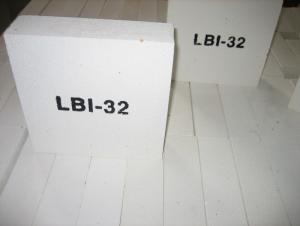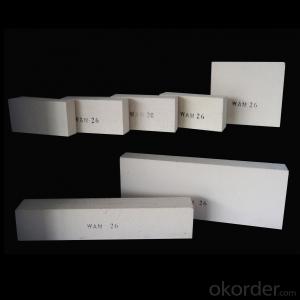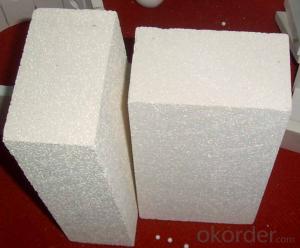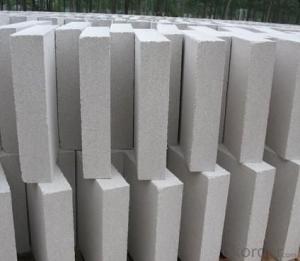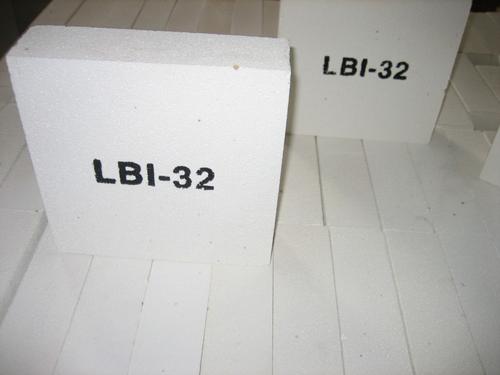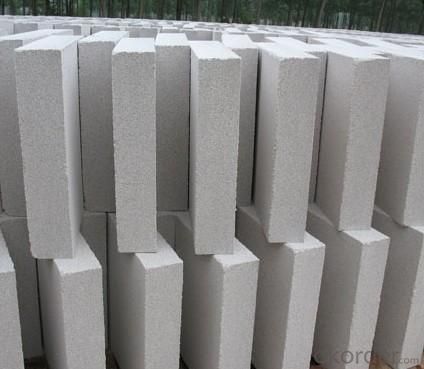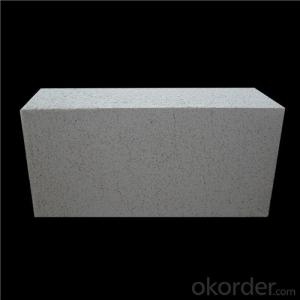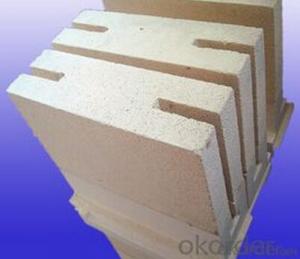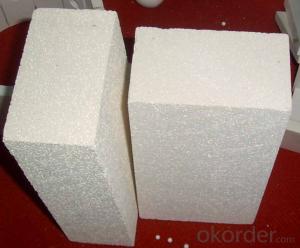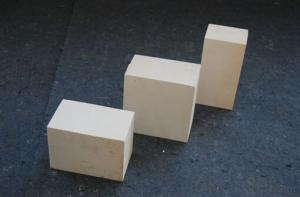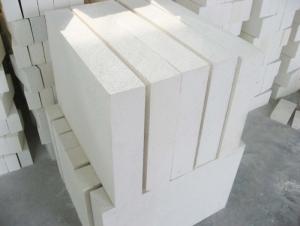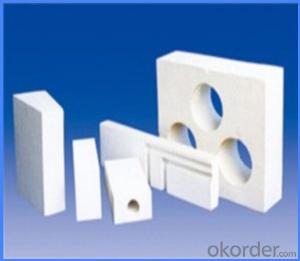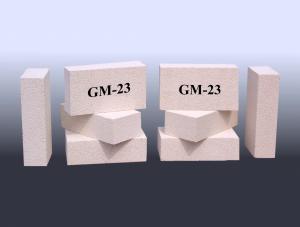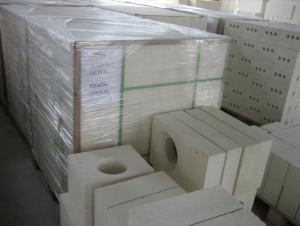Insulating Fire Brick - Refractory Mullite GJM30
- Loading Port:
- Shanghai
- Payment Terms:
- TT OR LC
- Min Order Qty:
- 20 m.t.
- Supply Capability:
- 100000 m.t./month
OKorder Service Pledge
OKorder Financial Service
You Might Also Like
General Information
CMAX insulating firebricks are classified under temperature between 1300℃ to 1700℃, manufactured from high purity alumina clay.
1. Lower content of iron, alkaline and impurities, good high temperature properties.
2. Homogeneous structure, light weight, energy saving because lower heat storage in the furnace during cooling cycles.
3. High strength, good thermal shock resistance under high temperature.
4. Precise sizes due to grinding and shaping after sintering, which meets the requirement of construction.
5. Max service temp: Up to 1730C (3160F)
Feature
Light weight and low thermal conductivity
Low heat storage
Low iron and impurities
High thermal shock resistance
Application
CMAX insulating firebricks can be used as a hot face lining directly exposed to the heat or as a backup insulation layer in iron and steel mills, non-ferrous foundries, petrochemical, ceramic, glass.
ITEM | GJM30 | GJM28 | GJM26 | GJM23 |
Classification Temperature, ℉/℃ | 3000/1650 | 2800/1540 | 2600/1430 | 2300/1260 |
Bulk Density,g/cm³ | ≤1.0 | ≤0.9 | ≤0.8 | ≥0.5 |
Reheating Linear Change, % | ≤0.9 (1550℃,12 h) | ≤0.8 (1510℃,12 h) | ≤0.7 (1410℃,12 h) | ≤0.5 (1230℃,12 h) |
Al2O3 Content, % | ≥75 | ≥65 | ≥55 | ≥45 |
Fe2O3 Content, % | ≤0.5 | ≤0.6 | ≤0.7 | ≤1.0 |
Thermal Conductivity: | ||||
800℃, w/m.k | ≤0.39 | ≤0.37 | ≤0.35 | ≤0.18 |
1000℃, w/m.k | ≤0.43 | ≤0.41 | ≤0.39 | ≤0.20 |
1200℃, w/m.k | ≤0.48 | ≤0.46 | ≤0.43 | --- |
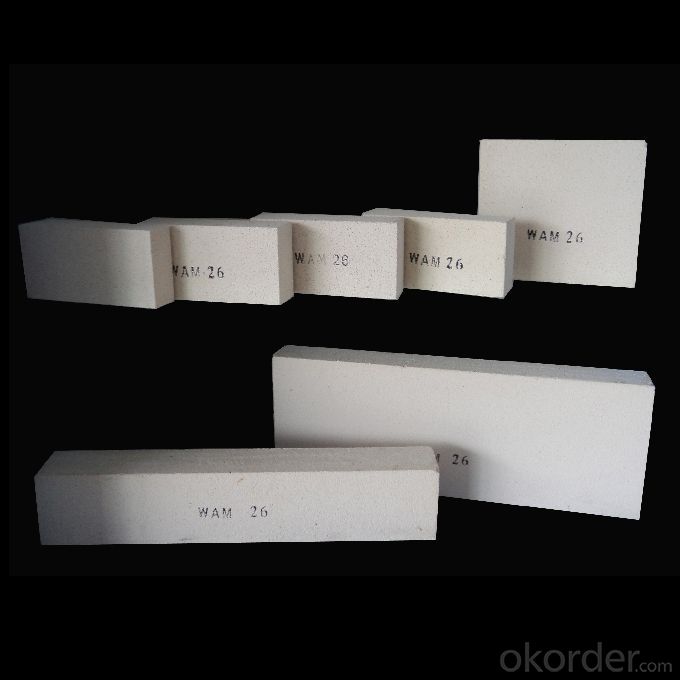
- Q: What are the different types of insulating fire bricks available in the market?
- In the market, one can find a variety of insulating fire bricks. Some of the frequently encountered types are as follows: 1. Lightweight Fire Bricks: These bricks are crafted from lightweight and porous materials like expanded clay, vermiculite, or perlite. They possess exceptional insulation properties and are commonly utilized in scenarios where weight is a critical factor, such as lining kiln or furnace walls. 2. Ceramic Fiber Bricks: These bricks are formed by compressing and shaping ceramic fibers. They exhibit high insulation properties, low thermal conductivity, and can withstand high temperatures. Ceramic fiber bricks are frequently employed in applications that demand insulation in high-temperature environments, such as constructing industrial furnaces or ovens. 3. Calcium Silicate Bricks: These bricks are produced from a combination of lime, silica, and reinforcing fibers. They possess favorable thermal insulation properties and are resistant to thermal shock. Calcium silicate bricks are commonly employed in situations where high-temperature insulation is necessary, such as building boilers or incinerators. 4. Magnesia Bricks: These bricks are composed of highly refractory magnesium oxide. They possess excellent thermal insulation properties and can endure extremely high temperatures. Magnesia bricks are often used in environments requiring insulation at high temperatures, such as lining steel-making furnaces or glass melting tanks. 5. Vermiculite Bricks: These bricks are made from naturally occurring expanded vermiculite. They exhibit good insulation properties, low thermal conductivity, and resistance to high temperatures. Vermiculite bricks are commonly used in applications that necessitate lightweight insulation, such as constructing chimneys or fireplace surrounds. In conclusion, the selection of insulating fire bricks depends on specific requirements like desired insulation level, temperature resistance, and weight considerations for the particular application.
- Q: Are insulating fire bricks suitable for use in thermal power plants?
- Yes, insulating fire bricks are suitable for use in thermal power plants. These bricks are designed to withstand high temperatures and provide excellent insulation, making them ideal for use in areas where heat needs to be contained, such as furnaces, boilers, and other thermal power plant equipment. Additionally, insulating fire bricks are resistant to thermal shock, meaning they can withstand rapid temperature changes without cracking or breaking.
- Q: Are insulating fire bricks eco-friendly?
- To some extent, insulating fire bricks can be considered environmentally friendly. These bricks are typically crafted from abundant natural materials like clay, shale, and other fire-resistant minerals. The manufacturing process involves firing the bricks at high temperatures, which can consume a lot of energy. However, advancements in manufacturing techniques have mitigated the environmental impact by using more efficient kilns and recycled materials. Furthermore, insulating fire bricks boast a long lifespan and can endure high temperatures. This means they require less frequent replacement compared to other brick types, resulting in reduced waste generation and resource consumption over time. Moreover, these bricks possess exceptional thermal insulation properties, which can contribute to decreased energy consumption in various applications. By minimizing heat loss, insulating fire bricks can enhance energy efficiency and reduce carbon emissions in both buildings and industrial processes. Nevertheless, it is crucial to note that the eco-friendliness of insulating fire bricks also hinges on their proper disposal at the end of their life cycle. If not recycled or disposed of appropriately, they can contribute to landfill waste and potential environmental pollution. In conclusion, while insulating fire bricks offer certain environmentally friendly features, such as being made from natural materials and their energy-saving properties, their overall environmental impact also depends on responsible manufacturing, usage, and disposal practices.
- Q: Are insulating fire bricks resistant to oil and gas?
- Insulating fire bricks typically offer resistance against oil and gas. These bricks are crafted from high temperature materials like alumina and silica, which grant exceptional thermal insulation qualities and can endure elevated temperatures. They are commonly employed in industries where exposure to heat occurs, such as furnaces, kilns, and fireplaces. Nevertheless, it is crucial to acknowledge that the resistance to oil and gas can vary depending on the precise composition and manufacturing process of the insulating fire bricks. Certain bricks may exhibit higher resistance to oil and gas compared to others. To guarantee the utmost resistance to oil and gas, it is recommended to utilize insulating fire bricks that are specifically engineered for such applications. These bricks are often known as oil and gas resistant fire bricks and are formulated with supplementary additives or coatings that enhance their resistance to these substances. In conclusion, although insulating fire bricks generally offer resistance to oil and gas, it is advisable to employ bricks that are specifically tailored for such applications to ensure optimal performance and longevity.
- Q: Do insulating fire bricks have a low thermal expansion rate?
- Yes, insulating fire bricks generally have a low thermal expansion rate. These bricks are designed to withstand high temperatures and thermal shocks, and one of their key properties is their ability to maintain their shape and dimensions under extreme heat conditions. Insulating fire bricks are made from materials that have a low coefficient of thermal expansion, meaning they expand and contract minimally when exposed to changes in temperature. This low thermal expansion rate ensures that the bricks remain stable and do not crack or break due to thermal stress. Additionally, the low thermal expansion rate of insulating fire bricks allows for better insulation performance, as it minimizes the gaps that can form between the bricks when they expand and contract, reducing heat loss and increasing energy efficiency.
- Q: Do insulating fire bricks have a high fire resistance rating?
- Insulating fire bricks possess an impressive fire resistance rating. These bricks are specifically crafted to endure elevated temperatures while providing exceptional insulation against heat transfer. They are composed of high-purity refractory materials, namely alumina and silica, which possess a high melting point and can withstand extreme heat. With the ability to endure temperatures reaching 3000°F (1650°C), insulating fire bricks exhibit significantly lower thermal conductivity compared to ordinary bricks or alternative materials. This renders them highly suitable for applications necessitating strong fire resistance, such as industrial furnaces, kilns, fireplaces, and chimneys. Moreover, their insulating properties aid in reducing heat loss, thereby promoting energy efficiency and cost-effectiveness.
- Q: Can insulating fire bricks be used in the construction of BBQ pits?
- Indeed, the utilization of insulating fire bricks is feasible for the construction of BBQ pits. These bricks are specifically engineered to endure extreme temperatures and possess exceptional heat resistance attributes, rendering them perfectly suited for BBQ pit applications. By incorporating these bricks, heat is effectively captured and evenly dispersed, leading to improved cooking efficiency and a more enjoyable BBQ experience. Moreover, the inclusion of insulating fire bricks aids in minimizing heat dissipation, guaranteeing that the BBQ pit retains and sustains heat for an extended duration. All in all, the integration of insulating fire bricks significantly enhances the overall performance and longevity of the BBQ pit.
- Q: How does an insulating fire brick work?
- Insulating fire bricks, which are also referred to as refractory bricks, serve as thermal barriers in various industrial applications and are designed to withstand high temperatures. These bricks are made from refractory materials that possess low thermal conductivity, indicating their poor heat conduction abilities. The primary mechanism employed by insulating fire bricks revolves around their capability to hinder and slow down heat transfer. Unlike regular bricks or concrete, insulating fire bricks possess a significant number of air pockets within their structure, which act as insulators. These air pockets effectively obstruct the movement of thermal energy, preventing heat transfer. When exposed to high temperatures, insulating fire bricks absorb minimal amounts of heat due to their low thermal conductivity. Rather than conducting heat through the brick, the energy is either absorbed or reflected by the air pockets present in the brick's structure. As a result, heat is unable to permeate to the other side of the brick, effectively creating a thermal barrier. Moreover, the refractory materials utilized in insulating fire bricks inherently possess resistance against thermal shock, enabling them to endure rapid temperature changes without cracking or breaking. This quality makes them exceptionally suitable for applications where extreme temperature fluctuations occur frequently. Insulating fire bricks find extensive usage in industries such as metallurgy, ceramics, glass manufacturing, and kiln construction. They are primarily used to line furnaces, kilns, and other equipment operating at high temperatures. By effectively reducing heat transfer, these bricks contribute to enhancing energy efficiency, minimizing heat loss, and safeguarding surrounding materials and structures from the extreme levels of heat. In summary, the operational principle of an insulating fire brick lies in its ability to minimize heat transfer by virtue of its low thermal conductivity and air pocket structure. By establishing a thermal barrier, these bricks fulfill a critical role in providing insulation, protecting against heat loss, and ensuring the smooth functioning of high-temperature processes.
- Q: Are insulating fire bricks suitable for use in lime kilns?
- Insulating fire bricks are indeed a suitable option for utilization in lime kilns. Lime kilns function at elevated temperatures, usually ranging from 900 to 1200 degrees Celsius. These insulating fire bricks are specifically constructed to endure such extreme temperatures and offer exceptional thermal insulation. With their low thermal conductivity, they aid in conserving heat and upholding high temperatures inside the kiln. Moreover, these bricks possess a lightweight nature and exhibit considerable resistance to thermal shock, rendering them ideal for the cyclic heating and cooling procedures employed in lime kilns.
- Q: Can insulating fire bricks be cut or shaped to fit specific applications?
- Insulating fire bricks possess the ability to be cut or shaped in order to accommodate specific uses. These bricks, composed of lightweight refractory materials like ceramic fibers or lightweight aggregates, maintain their structural integrity even when cut or shaped. To achieve desired dimensions or shapes for applications such as kiln lining, furnace construction, or fireplace installation, one can employ a saw, knife, or other cutting tools. Furthermore, molds or manual molding during the manufacturing process enable the shaping of insulating fire bricks. Due to their adaptability in cutting and shaping, these bricks offer great versatility and suitability for a diverse range of industrial and residential purposes.
Send your message to us
Insulating Fire Brick - Refractory Mullite GJM30
- Loading Port:
- Shanghai
- Payment Terms:
- TT OR LC
- Min Order Qty:
- 20 m.t.
- Supply Capability:
- 100000 m.t./month
OKorder Service Pledge
OKorder Financial Service
Similar products
Hot products
Hot Searches
Related keywords
